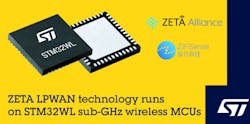STMicro Joins ZETA Alliance for LPWAN Technology
STMicroelectronics has joined the ZETA Alliance, the industry body promoting ZETA Low-Power Wide Area Network (LPWAN) technology for low-cost long-range IoT connectivity. ZETA technology is quickly becoming established throughout China, Japan, and beyond, bringing together innovative wireless technologies that enable low-power, low-cost devices to rely on robust connections over extended distances. In addition, native support for mesh networking, which allows peer-to-peer communication among the network nodes, boosts network coverage and resilience.
Joining the Alliance as a Promoter member, ST expects ZETA technology to further accelerate the spread of IoT in all territories worldwide. The standard lets developers create high-value IoT-based solutions to challenges that face extreme cost constraints. ST is working with ZiFiSense to port the technology to the highly integrated STM32WL wireless System-on-Chip (SoC) devices, which combine ultra-low-power microcontroller functionality with a wireless stage certified to international radio-equipment regulations on the same chip.
Further technical information
ZETA leverages an advanced M-FSK modulation and coding scheme created by ZiFiSense that allows the system to detect and demodulate signals from transmitters of extremely low power. M-FSK receiver sensitivity can get as low as -150dBm. Hence ZETA can achieve extremely long wireless-communication range with low transmitter output power.
The STM32WL SoC provides a convenient, power-efficient, and secure platform on which to develop IoT devices to leverage LPWAN connectivity. In addition to integrating the low-power microcontroller and radio front end on the same silicon die, which reduces the solution footprint and lowers the bill of materials, these devices permit further savings by requiring only a single crystal to synchronize the high-speed external (HSE) clock and radio.
The SoC delivers up to 22dBm RF output power without an external power amplifier. An alternative energy-optimized power output can deliver up to 15dBm. Such dual power output and a linear frequency range from 150MHz to 960MHz make the chip suitable for any geographic market.
As a worldwide compatible open platform, the STM32WL supports LoRa modulation scheme, as well as (G)FSK, (G)MSK and BPSK modulation used by ZETA, Sigfox, wireless Meter-Bus (wM-Bus), and many other proprietary protocols. ST enables a rich ecosystem of hardware development tools, software tools, and embedded software packages including LoRaWAN and Sigfox protocol stacks, ready to run out of the box on STM32WL SoCs.
ST’s other embedded products suited to use in equipment for LPWA networks include STM32MP1 microprocessors that combine an Arm Cortex-A7 application core and Cortex-M4 microcontroller core with powerful peripherals that are ideal for gateway devices, as well as STM32L0 and STM32L4 ultra-low-power microcontrollers that let battery energy go further in network endpoints.
